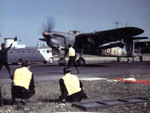Barracuda
| Country | United Kingdom |
| Manufacturer | Fairey Aviation |
| Primary Role | Dive Bomber |
| Maiden Flight | 7 December 1940 |
Contributor: C. Peter Chen
ww2dbaseBarracuda attack aircraft were the first British aircraft of this type to be constructed entirely of metal, replacing the wood-and-canvas Albacore biplanes that the British Fleet Air Arm employed. They entered service on 10 Jan 1943 and were found with British fleets in both the Pacific Ocean and the Atlantic Ocean by 1944, participating various missions such as attacking surface vessels and conducting anti-submarine patrols. Although they were originally designed as torpedo bombers, they were more effective as dive bombers due to the fact that the engine lacked the power to properly handle the weight of a torpedo during flight. Additionally, the powerful Youngman flaps doubled as excellent air brakes, the usage of which was an integral part of dives. Barracuda aircraft played a critical part in the disabling of battleship Tirpitz on 3 Apr 1944, which was accomplished by dive bombing. Pilots also enjoyed the excellent range of vision provided by the wide cockpit canopy, though some complaints were reported of the aircraft's slow rate of climb. Later on in the war, a problem was discovered where leaking hydraulic fluid was producing ether fumes into the cockpits and disabling the pilots. After some fatal crashes, the decision was made to equip Barracuda aircraft with oxygen masks and require their use.
ww2dbaseBarracuda aircraft were gradually replaced by US-built TBF Avenger aircraft during and after the war; the last few remained in service with the Fleet Air Arm until mid-1950s.
ww2dbaseSource: Wikipedia.
Last Major Revision: Mar 2007
Barracuda Timeline
| 7 Dec 1940 | The Fairey Barracuda dive bomber took its first flight. |
| 10 Jan 1943 | The Fairey Barracuda torpedo and dive bomber began its operational service with the Royal Navy's Fleet Air Arm with the delivery of twelve Barracuda II aircraft to the reformed No. 827 Squadron. |
SPECIFICATIONS
Mk II
| Machinery | One Rolls-Royce Merlin 32 liquid-cooled V12 engine rated at 1,640hp |
| Armament | 2x7.7mm Vickers K machine guns, 735kg bomb/torpedo carrying capacity |
| Crew | 3 |
| Span | 14.99 m |
| Length | 12.12 m |
| Height | 4.60 m |
| Wing Area | 37.62 m² |
| Weight, Empty | 4,445 kg |
| Weight, Loaded | 5,715 kg |
| Weight, Maximum | 6,385 kg |
| Speed, Maximum | 340 km/h |
| Speed, Cruising | 315 km/h |
| Service Ceiling | 6,585 m |
| Range, Normal | 1,165 km |
Photographs
 |  |  |  |
Please consider supporting us on Patreon. Even $1 per month will go a long way! Thank you. Please help us spread the word: Stay updated with WW2DB: |
Visitor Submitted Comments
9 Apr 2014 12:54:02 AM
The Barracuda was introduced into the Pacific theatre of war in April 1944 by No.810 and 847 Squadrons of the Fleet Air Arm embarked in HMS Illustrious. These are known to have supported US Navy dive bombers engaged in attacks on Japanese installations in Sumatra.
13 Apr 2015 02:54:39 AM
There's a typo in line seven, word six. Should read "powerful."
14 Apr 2015 06:55:26 PM
Thank you, the typographical error has been corrected.
17 Mar 2016 08:32:46 PM
how many aircraft in a fleet arm squadron late war
28 Jun 2017 08:31:40 AM
Sub Lt A C Warner died on 1 1 1945 when barracuda crashed when on simulated carrier landing training.
Further info. appreciated.
21 Jul 2017 06:12:19 AM
I am interested in any information about a Barracuda crashing at Ringway in the 40s killing a test pilot who worked for Fairey Aviation.
5 Jun 2019 08:08:45 PM
829 sqn 12 planes lee on solent 43
two planes crashed owl fearn one dec 43 the other jan 44
11 planes on victorious 3rd april 44
thats 13 planes
All visitor submitted comments are opinions of those making the submissions and do not reflect views of WW2DB.

» Carrier Aircraft Specifications
- » 1,171 biographies
- » 337 events
- » 44,911 timeline entries
- » 1,245 ships
- » 350 aircraft models
- » 207 vehicle models
- » 376 weapon models
- » 123 historical documents
- » 261 facilities
- » 470 book reviews
- » 28,521 photos
- » 365 maps
Winston Churchill, 1935
Please consider supporting us on Patreon. Even $1 a month will go a long way. Thank you!
Or, please support us by purchasing some WW2DB merchandise at TeeSpring, Thank you!
24 Sep 2013 09:12:00 AM
Actually no, it wasnt a gas leak it was a pressurised fluid system with a directly plumbed full pressure pressure gauge which had the nasty habit of shearing its connector spraying the pilot, cockpit controls and anything within range with nasty flammable hydraulic fluid, which by all accounts smelt quite nice but killed several pilots.